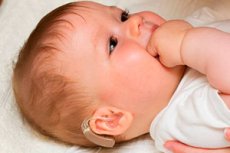
在最近发表在《自然医学》杂志上的一项研究中,研究人员评估了腺相关病毒 1 (AAV1)-人耳畸蛋白 (hOTOF) 双耳疗法对五名患有 9 型常染色体隐性耳聋 (DFNB9) 的儿童的安全性和有效性。
全球数百万人因 OTOF 基因异常而出现听力损失,从而导致 DFNB9。
基因治疗是治疗遗传性耳聋的一种有前途的治疗选择,研究表明单臂 AAV1-hOTOF 治疗是安全的并且具有功能益处。
双耳听力恢复可能带来额外的益处,例如改善言语感知和声音定位。然而,现有的抗AAV中和抗体可能通过引起免疫毒性和限制重复传播来阻止靶细胞和组织的感染。
本研究旨在评估双耳 AAV1-hOTOF 基因治疗对 DFNB9 患者的安全性和有效性。
研究人员对参与研究的316名志愿者进行了评估,其中5名因OTOF基因双等位基因突变导致双耳先天性听力损失的儿童(3男2女)于2023年7月14日至11月15日期间被纳入研究。
受试者均存在OTOF基因突变,且双耳脑干声音反应(ABR)水平≥65 dB。排除标准包括:AAV1中和抗体比例>1:2,000、既往耳科疾病、药物滥用史、复杂免疫缺陷或器官移植史、神经或精神疾病史以及放化疗史。
在一次手术中,研究人员通过耳朵的圆窗将 1.50 x 10^12 个 AAV1-hOTOF 载体基因组 (vg) 注入患者的双侧耳蜗。
受试者未出现剂量限制性毒性或严重不良事件。共发生36起1级或2级不良事件,其中最常见的是淋巴细胞升高(36例中有6例)和胆固醇升高(36例中有6例)。
所有患者均实现双侧听力恢复。基线时,右(左)耳平均ABR阈值大于95 dB。
26 周后,第一个患者的阈值恢复到 58 dB(58 dB),第二个患者的阈值恢复到 75 dB(85 dB),第三个患者的阈值恢复到 55 dB(50 dB),第四个患者的阈值恢复到 75 dB(78 dB),第五个患者的阈值恢复到 63 dB(63 dB)。
治疗后13周,接受双耳治疗的5名患者的平均ABR阈值为69 dB,接受单耳治疗的5名患者的平均ABR阈值超过64 dB。双耳基因治疗患者的平均ASSR阈值为60 dB,单耳患者的平均ASSR阈值为67 dB。
五名患者均恢复了言语感知和声源定位能力。研究团队发现,所有患者的 MAIS、IT-MAIS、CAP 或 MUSS 评分均有所提高。
治疗六周后,所有患者均产生了针对AAV1的中和抗体。双耳基因治疗患者的中和抗体滴度为1:1,215,而单耳基因治疗患者的中和抗体滴度范围为1:135至1:3,645。
治疗一周后,所有患者血液中载体DNA检测均未呈阳性。双耳AAV1-hOTOF基因治疗六周后,AAV1衣壳肽池的IFN-γ ELISpot检测结果为阴性。
基于该研究结果,双耳AAV1-hOTOF基因治疗对DFNB9患者安全有效。该研究结果拓展了治疗选择,并促进了由多种基因引起的遗传性耳聋基因治疗的进一步发展。

